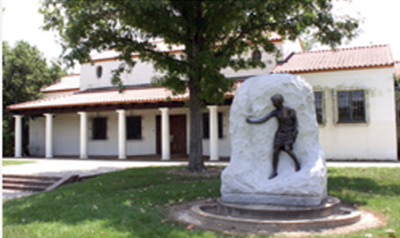January 23, 2024
MacGregor Park statue linked to Mt. Rushmore
 MacGregor Park is a lush oasis in the Houston Southeast Management District: 83 acres of green space east of the Texas Medical Center, boasting picnic grounds, a vibrant community center, swimming pool, basketball court, hike-and-bike trails, and the Homer Ford Tennis Center.
MacGregor Park is a lush oasis in the Houston Southeast Management District: 83 acres of green space east of the Texas Medical Center, boasting picnic grounds, a vibrant community center, swimming pool, basketball court, hike-and-bike trails, and the Homer Ford Tennis Center.
It is also home to Peggy, a bas-relief bronze statue of a young woman attached to a 28-ton piece of white granite. You may not know her history, you may not know her creator. But you certainly know the artist’s most famous work.
The visionary of MacGregor Park, Henry Frederick MacGregor, came to Houston in 1873 and became a prominent businessman and real estate developer. He developed the Riverside Terrace neighborhood.
In 1885 he married Elizabeth “Peggy” Stevens. Unlike her husband, who hailed from New Hampshire, Peggy was a native Houstonian who attended the city’s first high school and graduated from Huntsville Teacher’s College. She was active in civic and social affairs and involved with getting a YWCA building constructed in 1920. She might have been little more than a footnote in Houston history if not for her husband’s request that a statue of her be erected after his death. He died in 1923.
The commission went to John Gutzon Borglum, who was living in San Antonio and working on his Trail Drivers sculpture, which is displayed today inside the Witte Museum in that city.
After creating the Peggy statue, he went on to create the iconic presidential portraits on Mt. Rushmore in South Dakota.
Trail Drivers and Peggy are his only works in Texas.
Dedicated in 1927, the Peggy work included a water fountain, and was first placed in Peggy Park, a triangular pocket of land donated by the MacGregors, bounded by Wheeler, Almeda and Chenevert streets.
She was moved to Peggy Point Park in 1974; in 1996 the sculpture was moved again to its present location in MacGregor Park.
Years of misuse had taken their toll on the sculpture. Peggy was mysteriously missing its right arm and many of the blue tiles that bordered its base. The arm was either broken off and stolen by vandals or it possibly broke off during the 1974 move and was subsequently lost.
In 1976, Lincoln Borglum, John Gutzon’s son, made a replacement arm, but it was not installed until 1996.
According to the City of Houston: “The artist’s signature appears on the left side of her lower garment, as does the foundry mark (AMER. ART FDRY. NY) that is placed near the proper left hand. The original proper right arm was lost c. 1974; therefore, the artist’s son created a replacement that was installed in 1996. There is a chalice-shaped indentation beneath the plaque on the back of the granite block which indicates a prior location of a basin.”
The plaque reads: MAN IS NOT AT HIS BEST UNTIL HE/ HAS A WIFE AND A HOME AND SO MUCH/ DEPENDS UPON THE WIFE.” H.F.M./ IT WAS HIS WISH— AND HERE IN STONE/ AND BRONZE IS BUILDED A MEMORIAL./ MAY IT GRACE, PERPETUATE AND FULFILL/ THE CONCEPTION OF/ HENRY FREDERICK MACGREGOR/ THAT IN THIS PARK GIVEN AND DEDICATED/ BY HIM TO THE PEOPLE OF HOUSTON/ AND NAMED FOR HIS WIFE/ ELIZABETH STEVENS MACGREGOR/ WHOM HE AFFECTIONATELY CALLED “PEGGY,” SHOULD BE ERRECTED A FOUNTAIN AS A/ TRIBUTE TO THE INSPIRATION OF A DEVOTED WIFE.
Today Peggy stands in front of the MacGregor Fitness Center. You can learn about Peggy by using the Houston Parks and Recreation Department’s Art in the Parks, a multi-platform guide.
The program offers information on 91 pieces of municipal art located in 24 parks across Houston. Art in the Park is part of the City of Houston’s Civic Art Program, which curates 677 works around the city.
Now the Kinder Foundation and the city are lead partners in the eventual funding of a $54 million upgrade of MacGregor Park.
— by Marene Gustin
